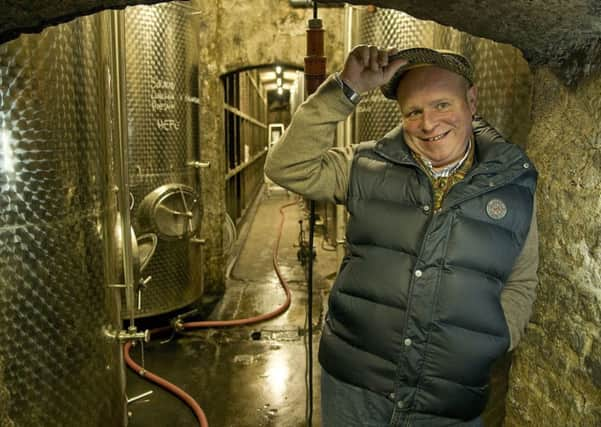Wine: Germany’s dry wine renaissance


Few have heard of him outside of his own country – so his wines remain underappreciated and undervalued.
Kesseler’s rise to fame as one of Germany’s top winemakers is all the more fascinating when you discover he is predominantly self-made. His father was a baker in the town of Assmannshausen on the northern banks of the Rhine. They owned two hectares of very steep vineyards which had been in the family since 1924 – but could not produce enough grapes to keep a family. August’s father worked day and night to keep both the bakery and vineyard going.
Advertisement
Hide AdAdvertisement
Hide Ad“When both my parents died early, before I reached the age of 20, I had to make a decision,” says Kesseler. “I had always fancied a career with cars or horses, but I decided to focus on wine so I enrolled at Geisenheim University for a year to study viticulture and try to make something of our family’s vines. I knew I could not survive with just two hectares, so I had to expand the estate or sell it,” he says.
Kesseler decided to focus on making quality dry wines, at a time when volumes of bulk sweet wines were the order of the day. He was the first in Germany to make top quality pinot noir (or Spätburgunder as it is called). Today he owns 22 hectares on prime vineyard sites in Assmannshausen, Lorch and Rudesheim with a thriving business employing 40 people at its busiest time at harvest, with all grapes handpicked and hand-carried off the steep terraced slopes.
Assmannshausen in Rheingau is one of very few areas in Germany where pinot noir flourishes (the other main region is Baden). The steep slopes and deep slatey soils around Assmannshausen are among the hottest vineyards in Germany, thanks to a combination of the sun’s reflection from the river, slate absorbing its rays and the man-made terraced walls acting as an amphitheatre, trapping the summer warmth, helping to ripen the grapes.
“Our town has had a long tradition growing pinot noir since Benedictine monks brought the original clones from Clos de Vougeot in Burgundy,” says Kesseler. “Not many people realise that Germany is now the third largest producer of pinot noir in the world – that is because we have not always made good wine here,” he says.
In 1977, when Kesseler began making wine as a teenager, the pinot noirs were harvested with high acid. Malolactic fermentation was halted to retain malic acid and the wines were ‘balanced’ with sweet grape juice. “The result was light, sweet, sour and very poor – so I decided to pick later and let the malolactic go through and ferment the pinot to dryness,” he says. Today Assmannshausen Spätburgunder is Germany’s most elegant and spiciest pinot noir – different from the fruitier, fuller-bodied styles found in southern Baden, which bear more resemblance to Burgundy.
“Fifteen years after I started with pinot noir, I then fell in love with riesling too,” says Kesseler. So he now focuses on dry, off dry and quality sweet rieslings from his vineyards in Lorch to the north of Assmannshausen and Rudesheim to the east in the heartland of the famous Rhine vineyards.
As he reels off his successful pinot noir vintages (2002, 2004, 2005, 2007, 2009, 2010, 2012) Kesseler admits that growing vines in Germany is now much easier for him thanks to global warming, increasing temperatures a couple of degrees, than it was for his father and grandfather, who struggled to ripen their grapes each year.
Kesseler now also has the time and money to indulge his childhood interests. When not tending his steep slopes, he spends his spare time riding his horses ‘western-style’.
Our recommendations:
DRY WHITE
Advertisement
Hide AdAdvertisement
Hide AdRIESLING KABINETT ‘TROCKEN’ 2012 August Kesseler (£14.46, 12 per cent)
This is a wine to convert any riesling lover to try more German examples. Beautifully clean, bright, citric fruit; light, minerally core; vibrant natural acidity and long, dry, crisp finish.
Food match Light summer salad, quiche, salmon or mackerel fishcakes.
SWEET WHITE
LORCHER SCHLOSSBERG RIESLING AUSLESE 2011 August Kesseler (£30.46, 11.5 per cent)
Gorgeous bright fruits, gentle honeyed sweetness on the palate, minerally undertones, mouthwatering acidity, finishes long and dry: a very fine dessert wine from his northerly Lorch vineyards.
Food match Serve this young riesling with fruit, then blue cheeses or foie gras when it has matured.
RED
PINOT NOIR ‘TROCKEN’ 2010 August Kesseler (£23.46, 14 per cent)
A very pretty light Spätburgunder with elegant spice notes and bright natural acidity with an attractive price for German pinot.
Advertisement
Hide AdAdvertisement
Hide AdFood match Creamy goats cheese, roast pork, pigeon or venison.
• August Kesseler wines are available exclusively from Justerini & Brooks (0131-226 4202, www.justerinis.com).
• Join Rose’s French Classics and French Charcuterie Masterclass on Thursday 12 June at Abode, 129 Bath Street, Glasgow, £40, www.rosemurraybrown.com